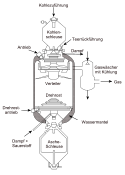CSIRO ScienceImage 11135 Dr Valerie Sage working at SynCat CSIROs Synfuel and Catalysis Research Facility
Größe:
2657 x 1765 Pixel (2865098 Bytes)
Beschreibung:
Dr Sage is working as a Research Scientist in the Gas Processing and Conversion group. Her research focus is on Gas-to-Liquid (GTL) technologies and she currently leads the Modified Fischer-Tropsch Process for Synfuels project, within the Energy Transformed National Research Flagship. Natural gas can be cooled to form Liquefied Natural Gas (LNG) or chemically converted to transport fuels such as gasoline and diesel, and chemicals. Processes that convert natural gas to liquid fuels are known as Gas-to-Liquids or GTL processes. CSIRO's Gas Processing and Conversion research program is developing technologies to more cost effectively develop cleaner fuels and chemical processes using Australia's abundant natural gas resources. These GTL technologies provide the nation's energy sector with the opportunity to fully utilise Australia's hydrocarbon resources, enhancing our sustainability and security in energy whilst helping to reduce greenhouse gas emissions.
Weitere Informationen zur Lizenz des Bildes finden Sie hier. Letzte Aktualisierung: Mon, 13 Nov 2023 02:37:55 GMT
Relevante Bilder
Relevante Artikel
Fischer-Tropsch-Synthese
Die Fischer-Tropsch-Synthese ist ein großtechnisches, heterogenkatalytisches Polymerisationsverfahren zur Herstellung von Kohlenwasserstoffen. Dabei wird an cobalt- oder eisenhaltigen Katalysatoroberflächen adsorbiertes Kohlenstoffmonoxid mit Wasserstoff hydriert. Die Reaktionen finden bei Temperaturen von etwa 150 bis 350 °C und Drücken von 1 bis etwa 25 bar statt. Das Verfahren umfasst die Erzeugung von Synthesegas, dessen Umsetzung zu Fischer-Tropsch-Produkten und deren Weiterverarbeitung. Für die Erzeugung des Synthesegases stehen Kohle, Erdgas, Biomasse oder organischer Abfall als Rohstoffquellen zur Verfügung. Aufgrund der Vielzahl möglicher Einsatzstoffe nimmt die Fischer-Tropsch-Synthese eine zentrale Stellung bei der Suche nach Alternativen zum Erdöl zur Gewinnung flüssiger Kohlenwasserstoffe ein.
.. weiterlesen

























